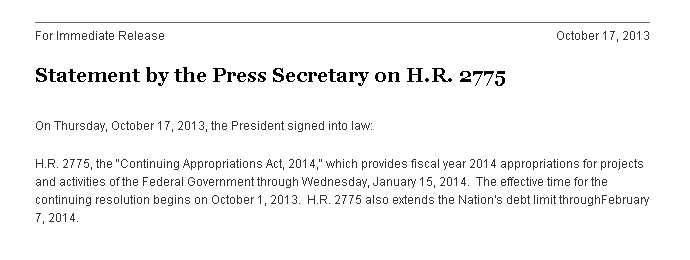Buying time: US budget deal postpones financial doomsday
President Obama and Congress have signed off on extending the debt ceiling through to February. The new legislation only temporarily solves the US budget dispute, begging the question if America will ever limit its borrowing.
The extension deal will reopen the government after 16 days of
partial shutdown and fund spending through January 15 while
extending the $16.7 trillion debt ceiling through to February 7. The next major
deadline is the December 13 target date for budget negotiations.

In three months’ time, US policymakers will again rehash the budget and the debt limit, which billionaire Warren Buffett called a “political weapon of mass destruction” in an interview with CNBC, saying it shouldn’t be used by politicians to settle budget disputes, as it brings real financial harm.
Although US policymakers haven’t specified the new borrowing limit, the Bipartisan Policy Centre think tank estimated the debt limit should be raised by another $1.1 trillion to help Washington cover its obligations through to December 2014.
Standard & Poor's estimates the shutdown cost the US economy $24 billion, or $1.5 billion per day, the rating agency said on Wednesday. The agency also believes the shutdown will pare fourth quarter GDP by 0.6 percent.
Even though the White House and lawmakers nearly avoided a technical debt default this time around, the solution is only temporary.
Wall Street rejoiced after news broke the Senate reached a deal to avert a default, the Dow Jones Industrial Average soared 200 points. At the close of the New York Exchange, the Dow Jones climbed 1.36 percent nearly reaching a record, the S&P 500 increased 1.38 percent, and the NASDAQ Composite jumped 1.20 percent.
Asian floors met the news with split enthusiasm, but general market sentiment was high on news the world’s largest economy wouldn’t experience a sovereign debt default.
"There will be resurgence in global markets until we come to the next round of discussions in February next year,” Malcolm Coates, a partner at Deloitte CIS, wrote in a note to RT.
“Can the US afford to default? The answer is a resounding no. There is nothing to gain from a default,” Coates told RT.
The sky is falling!
“The short turnaround for politicians to negotiate some sort of lasting deal will likely weigh on consumer confidence,” S&P wrote.
The political stalemate in Washington has already prompted consumers to devalue their outlook of the American economy, and hit its sharpest one-week drop since the collapse of Lehman Brothers.
“If people are afraid that the government policy brinkmanship will resurface again, and with it the risk of another shutdown or worse, they'll remain afraid to open up their check books. That points to another Humbug holiday season,” the agency said in their report.
When Congress neared the ‘fiscal cliff’ in the summer of 2011, consumer confidence fell to a 31-year low in August.
The beauty of the debt is its payment
Coming very close to defaulting on their debt and a last minute limit increase isn’t a new practice in Washington. The US debt ceiling has been in place for nearly a century, and the country’s policymakers have always raised their spending powers, simply borrowing money and writing a big ‘IOU’ to the American people.
America’s debt ceiling, or the amount of debt the government can
hold, has been increased 79 times since 1960, under both
Democratic and Republican Presidential administrations. The
outstanding debt of the world’s largest economy is currently
$16.7 trillion, and is spread through domestic and foreign debt.
“Nobody’s ever been this deep in debt and its going higher and higher,” said Jim Rogers, chairman of Singapore-based Rogers Holdings, told RT.

Investors and central banks shouldn’t continue fixating on the politics, but on the growing danger of the debt itself, Martin W. Hennecke, chief economist at Henley Group Ltd, told RT.
“…the real problem is not a debt ceiling, the problem is a debt. And a real issue, from our point of view, the investors and the central banks should be looking at is the danger of it growing and now, more recently, it’s coupled together with the issue of rising interest rates,” Henley Group said.
Rising interest rates will be important to watch because if Treasuries rise, paying off debt will be more expensive for the US.
“Any further increase in the interest rates, generally and on Treasuries, would send the United States into default, not just by disagreement, just because they run out of money,” Hennecke said.
The budget wars in Washington give investors a hint that policy makers will likely delay tapering their $85 billion-per-month bond purchasing program, known as quantitative easing. The Fed surprised markets on September 18 when they decided to refrain from reducing bond purchases.
“I think they are more likely to continue easing policies. Maybe they will expand their quantitative easing rather than tapering, because tapering would immediately cause the interest rates to go up,” Martin W. Hennecke, chief economist at Henley Group Ltd, told RT.














